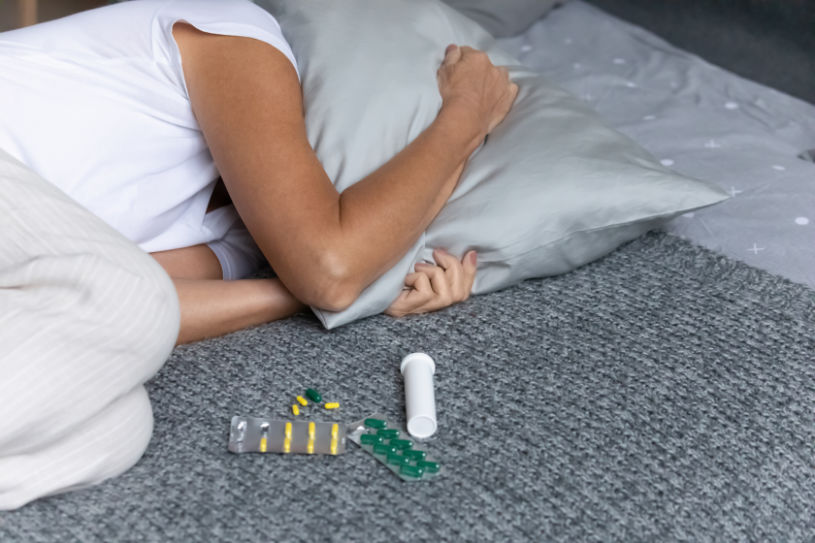Lisdexamfetamine dimesylate, whose brand name is Vyvanse, belongs to the classification of drugs called amphetamines. This medication’s primary use is for the treatment of Attention Deficit Hyperactivity (ADHD) and Binge Eating Disorder (BED). In 2018, around 10 million prescriptions of this drug were issued in the United States. Although this prescription medication is an effective drug for the previously said two conditions, the British Journal of Oral and Maxillofacial Surgery reported that there is a possibility for patients, including children who are 6 years old and older, to experience withdrawal (physical and mental side effects after stopping the use of the medication) and tolerance (the ability of the drug to work effectively).
Table Of Contents:
In this article, information about Vyvanse tolerance and withdrawal, including the signs and symptoms of these two conditions, Vyvanse withdrawal timeline, and the proper way to stop using the drug Lisdexamfetamine will be provided.
Tolerance can be thought of as the first step on the road to addiction. So, how does tolerance lead to addiction, and what happens when the patient suddenly stops using the medication?
Vyvanse Tolerance: What Is It?
While Lisdexamfetamine can be addictive, addiction is not nearly as common as tolerance. Tolerance is the diminished physical response to a given drug after repeated use or drug abuse. This occurs because the body becomes used to the presence of the drug. However, not every person who takes the drug long-term will experience tolerance.
There Are Some Factors That Affect the Patients’ Vyvanse Tolerance:
- Patient’s age
- Patient’s weight
- Patient’s body fat and muscle content
- How much Lisdexamfetamine has been consumed
- Drugs being taken together with Lisdexamfetamine
- How long the patient has been using Lisdexamfetamine
Moreover, for those who experience Vyvanse tolerance, it cannot be denied that this can be distressing and these people have the risk of encouraging themselves to take more of the drug or combine it with other substances for it to give them their desired effects. However, this can only increase the risk of overdose and this requires immediate medical help.
Recognizing Vyvanse Tolerance
Take note that some people using this medication may experience Vyvanse tolerance. For people with ADHD, doctors from the Florida International University stated that even children with the ADHD condition can develop tolerance to Lisdexamfetamine. As such, users need to be able to recognize the signs of tolerance so they can seek treatment before becoming addicted to the drug.
Common Signs of Vyvanse Tolerance Include:
- Feeling that Lisdexamfetamine is not working anymore
- Having the symptoms, the medication is meant to treat come on stronger
- Becoming agitated when the results are not meeting the expectations
- Noticing that how long Lisdexamfetamine takes to start working is getting longer and longer
- Feeling as though the effects are wearing off faster than before
- Experiencing symptoms similar to withdrawal despite still taking the medication
- Considering increasing the dose taken or ways to amplify the effects of the drug
- Looking into methods for Vyvanse tolerance reset
Once signs of tolerance are noted, the patient should make an appointment with their doctor regarding how much of the drug to take. The doctor may choose to increase the dose safe to consume, or suggest ways to potentiate the drug. They may choose to switch to a new medication as there are many drugs similar to Lisdexamfetamine.

Drug Tolerance And Vyvanse Withdrawal
Remember that tolerance has a role in drug abuse. First, the user develops tolerance to Lisdexamfetamine. Then, they become dependent. Finally, addiction begins. When patients use Lisdexamfetamine and they feel like this drug is no longer working or the drug is not giving them the effects they desire, the tendency is that the people will take more of the drug and this is actually abuse. Doctors from the University of California Los Angeles claim that when patients use Lisdexamfetamine more than the prescribed amount, this may lead to addiction, as tolerance is one of the warning signs. Moreover, when the patient has to stop using the medication for certain reasons like when the treatment is over or there is a need to change medications, there will be a possibility of withdrawal.
Other Causes of Vyvanse withdrawal Are The Following:
- Sudden stop in the use of Lisdexamfetamine
- The inability of the body to maintain and modify neurotransmitter stability (imbalanced homeostasis)
- Hormonal imbalance due to inability to adapt easily to the lack of the drug
To avoid Vyvanse tolerance and withdrawal, it is a must for every patient to follow the doctor’s instructions consistently, diligently, accurately. Never miss a dose or increase a Lisdexamfetamine dose, as it may result in such side effects as low sex drive. Doing this will not only help the patient avoid tolerance and dependence but will also help in avoiding Lisdexamfetamine overdose.
Vyvanse Withdrawal Symptoms And Signs
If a patient is taking a medication that comes with a possibility of withdrawal, it is a must for every patient and parent (if the patient is a child) to know the Vyvanse withdrawal symptoms and signs. The following information is about symptoms when the drug use is stopped and these are likely to occur once the use of the drug has been stopped or the amount of dosage is not enough for the patient:
- Anxiety
- A feeling of fatigue and tiredness
- Lack of sleep
- Feelings of depression
- Irritability
- Intense craving
- Headache
- Mood swings
- Lack of motivation
- Increased appetite
- Uncontrollable body shakiness
- Lethargy
Take note that even children who are using Lisdexamfetamine are vulnerable to these Vyvanse withdrawal signs and symptoms. In case a patient is seen to be experiencing any of these signs and symptoms listed above, contact or seek immediate medical help in order to avoid unwanted health events. Aside from these, there are also post-acute Vyvanse withdrawal symptoms related to amphetamine use such as:
- Memory problems
- Inability to focus and concentrate
- Lack of self-control
- Anhedonia (inability to feel pleasure)
Lastly, there are medical complications related to amphetamine or Vyvanse withdrawal. Some of these complications are cardiac problems (chest pain and irregular heartbeat) and headaches caused by bleeding in or around the brain. Any patient experiencing these signs must contact or seek emergency medical help as soon as possible in order to have appropriate medical health recovery intervention treatment.

Vyvanse Withdrawal Timeline
Remember that the withdrawal timeline for Lisdexamfetamine or any other drug depends on different factors such as the patient’s biological factors, frequency, dose, and length of drug use, other drugs and substances being used together with Lisdexamfetamine, and other medical health conditions. For example, a healthy patient is less likely to experience severe withdrawal symptoms. Anyhow, whether the patient is healthy or not, withdrawal is dangerous to the physical and mental health of every user.
Moreover, Vyvanse withdrawal signs and symptoms are usually seen within the first 36 hours after the patients have taken their last dose of the drug. This, then, can last for several weeks and the patient will stay irritable and unmotivated. During the first weeks, patients will spend most of their time sleeping. They will feel extreme exhaustion and their mood and energy will decline. To understand more, below is simplified information about the Lisdexamfetamine withdrawal timeline:
- First two days – Referred to as “crash”, this is the period when patients will have an increased need for sleep and an urge to eat and sleep more.
- Three days to two weeks – During this period, patients will continue to have mood swings, irritation, joint aches and muscle pains, depression, and fatigue. Also, during this period, some patients might have trouble sleeping.
- Two weeks to twelve months – Take note that some withdrawal effects may last up to one year especially when the patient has used Lisdexamfetamine for a long period of time. During this period, patients will feel anxiety and irritability.
As said, the withdrawal timeline is different for every patient. It is advised for every patient using Lisdexamfetamine to consider medical assistance when withdrawal symptoms start to appear. Some may opt to have a medical professional intervene with the patient to get a solution-oriented process in addressing the withdrawal.
Stopping Lisdexamfetamine Use
There isn’t any medical treatment of Vyvanse withdrawal symptoms; however, there are certain dietary and hydration regimens that can be used to help remove Vyvanse from the system safely, and in managing the symptoms. Hence, knowing when and how to stop taking Lisdexamfetamine is important. Once some side effects start showing, it is an indication that someone should ask their doctor whether it is an option to stop taking the drug. In addition, Lisdexamfetamine should be stopped if the drug does not work well with the patient’s brain chemistry. The most helpful methods of stopping Lisdexamfetamine are tapering and detox.
Tapering is when a patient gradually stops taking drugs by increasingly reducing the dosage of Vyvanse product forms. It helps manage the lisdexamfetamine comedown symptoms to a certain extent. On the other hand, detox is a process where the body allows itself to get rid of the drug. Moreover, behavioral-based therapy and medication must be done together with the detox process for a more effective recovery.
People getting off or undergoing recovery from Lisdexamfetamine should consult a medical doctor before tapering because a doctor can advise on the dosage to take gradually as they monitor the outcome. Although there may not be specialized medication to treat withdrawals, specific medication can only be administered by a professional. It is, therefore, important to contact or seek professional addiction treatment for a safe and effective recovery process.
Hope Without Commitment
Find the best treatment options. Call our free and confidential helpline
Most private insurances accepted
Page Sources
- Berman, S. M., Kuczenski, R., McCracken, J. T., & London, E. D. (2009). Potential adverse effects of amphetamine treatment on brain and behavior: a review. Molecular psychiatry, 14(2), 123-142.
- Center for Substance Abuse Treatment. (2006). 4 Physical Detoxification Services for Withdrawal From Specific Substances. In Detoxification and substance abuse treatment. Substance Abuse and Mental Health Services Administration (US).
- Department of Health | The amphetamine withdrawal syndrome. (2004). Department of Health. https://www1.health.gov.au/internet/publications/publishing.nsf/Content/drugtreat-pubs-modpsy-toc%7Edrugtreat-pubs-modpsy-3%7Edrugtreat-pubs-modpsy-3-7%7Edrugtreat-pubs-modpsy-3-7-aws
- Examining Tolerance to CNS Stimulants in ADHD - Full Text View - ClinicalTrials.gov. (2014). ClinicalTrials.Gov. https://clinicaltrials.gov/ct2/show/NCT02039908
- Kane, S. P. P. (2018). Lisdexamfetamine Dimesylate - Drug Usage Statistics, ClinCalc DrugStats Database. ClinCalc. https://clincalc.com/DrugStats/Drugs/LisdexamfetamineDimesylate
- Patel, S., Schmidt, C., Blancher, A., & Ghali, G. E. (2019). Lisdexamfetamine (Vyvanse) Withdrawal in Children with Orofacial Cleft and Attention-Deficit/Hyperactivity Disorder. British Journal of Oral and Maxillofacial Surgery, 57(10), e24-e25.
- SA Health | Amphetamine Withdrawal Management. (2021). Government of South Australia.
- SAMHSA | Substance Abuse Treatment. (2010). Protracted Withdrawal, 10(1). https://store.samhsa.gov/sites/default/files/d7/priv/sma10-4554.pdf

 Authored by
Authored by  Reviewed by
Reviewed by 
